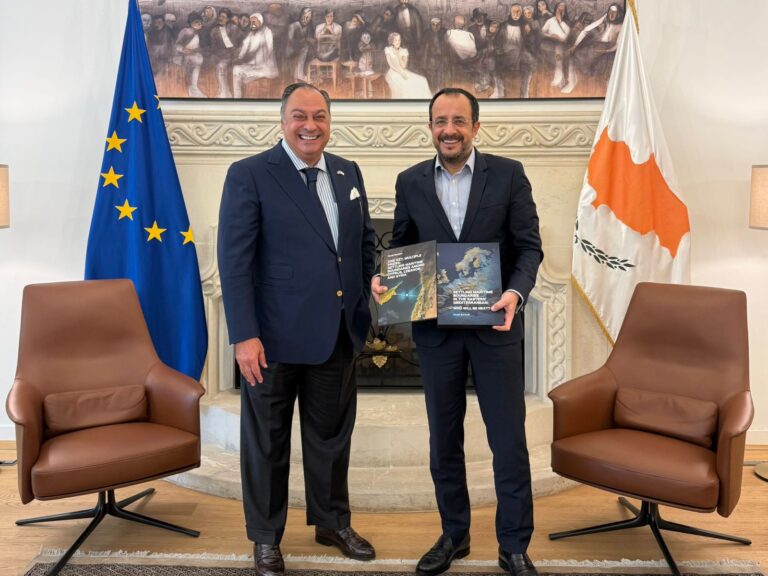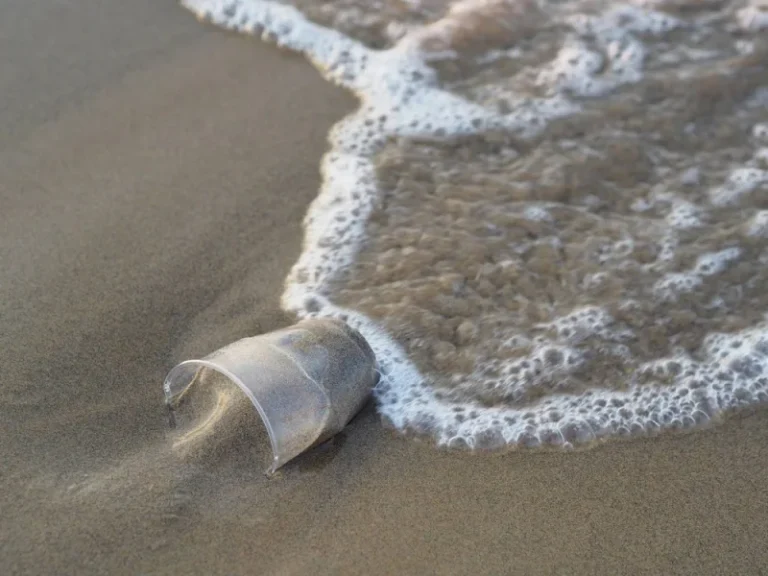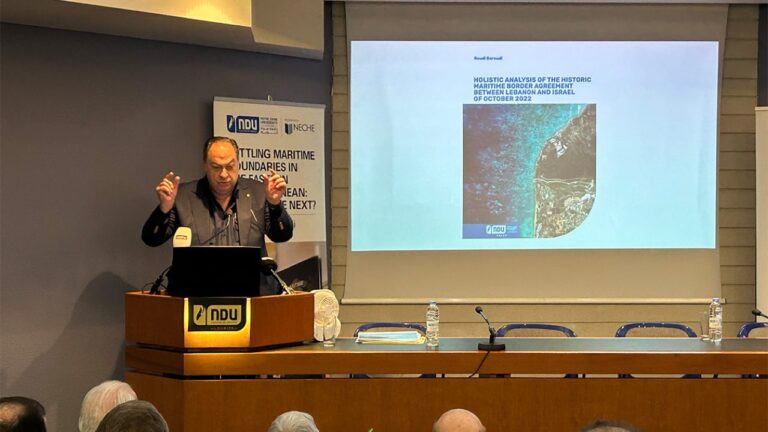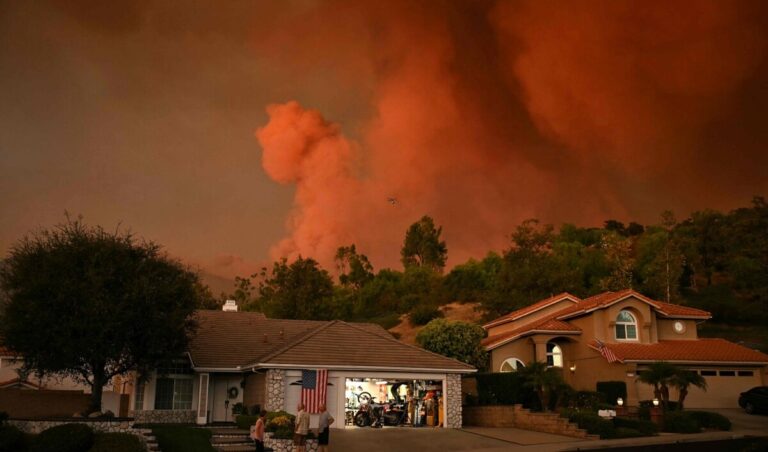اتفاية ترسيم الحدود البحرية مع قبرص



Οι τεταμένες σχέσεις Ισραήλ-Λιβάνου και οι ραγδαίες εξελίξεις στη Μέση Ανατολή έχουν κινητοποιήσει τη Λευκωσία για επαφές υψηλού επιπέδου για την επικύρωση της ΑΟΖ με το Λίβανο. Ετσι ο πρόεδρος της Κύπρου Νίκος Χριστοδουλίδης συναντήθηκε με τον εμπειρογνώμονα περιφερειακής πολιτικής Ρούντι Μπραούντι, μακροχρόνιος υποστηρικτής του διαλόγου, της διπλωματίας και της ειρηνικής ανάπτυξης, ως προς τις ασφαλέστερες διαδρομές προς μεγαλύτερη σταθερότητα για ολόκληρη την Ευρω-Μεσογειακή περιοχή και άτυπο διαμεσολαβητή των δύο χωρών. Μάλιστα έχει γράψει και σχετικά βιβλία, όπως την «οριστικοποίηση Θαλάσσιων Συνόρων στην Ανατολική Μεσόγειο: Ποιος Θα Ειναι ο Επόμενος;» και «Ένα Κλειδί, Πολλαπλά Έπαθλα: Οριστικοποίηση Θαλάσσιων Συνόρων ανάμεσα στην Κύπρο, το Λίβανο και τη Συρία».
Ο κ. Χριστοδουλίδης και ο ομόλογός του από το Λίβανο, ο πρώην Γενικός Τζόζεφ Αουν, συμφώνησαν τον Ιούλιο να διαπραγματευτούν και να οριστικοποιήσουν μια γραμμή θαλάσσιων συνόρων . Και οι δύο χώρες αναμένουν ότι θα αποκομίσουν πολλά οφέλη από μια τέτοια συμφωνία, και η κατοχύρωση εδαφικών συνόρων στη θάλασσα θα καταστήσει ευκολότερη την προσέλκυση ξένων επενδυτών για την ανάπτυξη των ενεργειακών πηγών τους.
«Η επίτευξη συμφωνίας θα ανοίξει όλες τις πόρτες για την Κύπρο και το Λίβανο», δήλωσε ο κ. Μπαρούντι μετά από τη συνάντηση. «Οι τάσεις πηγαίνουν στη σωστή κατεύθυνση, και όχι μόνο σε σχέση με το Λίβανο. Ο πρόεδρος της Κύπρου έχει φιλόδοξα σχέδια εξωτερικής πολιτικής, ιδιαίτερα σχετικά με τις δραστηριότητες της Κύπρου τους πρώτους έξι μήνες του 2026, όταν θα έχει την προεδρία του συμβουλίου της Ευρωπαϊκής Ένωσης».
«Εκμεταλλεύτηκα επίσης την ευκαιρία να ευχηθώ στο πρόεδρο της Κύπρου καλή επιτυχία σε αυτή την αποστολή», πρόσθεσε, «ειδικά καθώς αναμένεται να εστιάσει όχι μόνο στην ενίσχυση της συνοχής της Ευρώπης, αλλά και στην ενίσχυση του ρόλου της Κύπρου ως γέφυρα μεταξύ Ευρώπης και γειτονικών χωρών.»
Πράγματι, η Λευκωσία έχει ένα φιλόδοξο πρόγραμμα για την προεδρία της και συνεργάζεται στενά με τη Δανία, που ασκεί την προεδρία αυτό το εξάμηνο , και την Πολωνία, που θα διαδεχθεί την Κύπρο. Η λεγόμενη«τριπλή προεδρία» βοηθά στη διασφάλιση συνέχειας από τη μία προεδρία στην επόμενη.
Ο κ. Μπαρούντι έχει γράψει αρκετά βιβλία και μελέτες σχετικά με το πώς τα υπάρχοντα εργαλεία του ΟΗΕ μπορούν να βοηθήσουν τις παράκτιες χώρες να συμφωνήσουν δίκαια και ισότιμα θαλάσσια σύνορα, να μειώσουν τις εντάσεις και να αποκομίσουν σημαντικά οικονομικά και κοινωνικά οφέλη. Έχει επίσης γράψει και μιλήσει δημόσια για διάφορες ευκαιρίες περιφερειακής συνεργασίας, από διασυνδεδεμένα ενεργειακά δίκτυα και υπεράκτια αιολικά πάρκα μέχρι κοινή διαχείριση θαλάσσιων προστατευόμενων περιοχών.
Το 2023, απονεμήθηκε στον κ. Μπαρούντι το Βραβείο Ηγεσίας από το Transatlantic Leadership Network, ένα think-tank της Ουάσινγκτον, για τη «πολύτιμη συμβολή του στην οικοδόμηση μιας ειρηνικής και ευημερούσας Ανατολικής Μεσογείου».
Σε δεκάδες άρθρα, μελέτες, εμφανίσεις στα μέσα ενημέρωσης και ομιλίες, για παράδειγμα, ο βετεράνος της κλάδου έχει τεκμηριώσει την επιχειρηματική βάση για το νησιωτικό κράτος να γίνει κέντρο επεξεργασίας και διανομής φυσικού αερίου για τους γείτονές του. Αυτό θα περιελάμβανε την Κύπρο να δημιουργήσει έναν υπόθαλάσσιο αγωγό φυσικού αερίου προς την ευρωπαϊκή ενδοχώρα, ένα εργοστάσιο υγροποιημένου φυσικού αερίου (LNG) που θα ήταν το μεγαλύτερο έργο που έχει ποτέ η χώρα, ή και υπεράκτια πλωτά συστήματα αποθήκευσης και υγροποίησης για την εξυπηρέτηση απομακρυσμένων χωρών δια θαλάσσης.
«Όλες αυτές οι μελέτες και οι παράγοντες που ανέδειξαν παραμένουν επίκαιροι σήμερα», δήλωσε ο κ. Μπαρούντι. «Η Κύπρος διαθέτει την εγγύτητα, τις τιμές γης και τις σχέσεις με τους γείτονές της για να γίνει ο συνεταιριστής όλων στις εξαγωγές ενέργειας, αλλά και να λειτουργήσει ως θεμέλιος λίθος για μια πιο σταθερή και ευημερούσα περιοχή.»

NICOSIA – 29, September 2025: Cypriot President Nikos Christodoulides met today with the international energy policy expert, Roudi Baroudi, who presented copies of his two latest books, “Settling Maritime Boundaries in the Eastern Mediterranean: Who Will Be Next?” and “One Key, Multiple Prizes: Settling Maritime Boundaries Among Cyprus, Lebanon, and Syria”.
Baroudi, a long-time advocate of dialogue, diplomacy, and peaceful development as the surest routes to greater stability for the entire Euro-Med region, said he felt “honored to have been received by the President.”
Christodoulides and his Lebanese counterpart, former General Joseph Aoun, agreed in July to have their respective teams negotiate and finalize a maritime boundary line (MBL). Both countries expect to derive numerous benefits from such a pact, and having treatied borders at sea will make it easier to attract the foreign investors required to develop their respective offshore oil and gas resources.
Reaching a deal “will open up all sorts of doors for Cyprus and Lebanon,” Baroudi said after the meeting. “The trends are going in the right direction, and not just vis-à-vis Lebanon. The President has ambitious foreign-policy plans, particularly with regard to Cyprus’ activities for the first six months of 2026, when it will hold the rotating presidency of the European Union.”
“I also took the opportunity to wish His Excellency every good fortune on that mission,” he added, “especially since it is expected to focus not only on shoring up Europe’s cohesion, but also on beefing up Cyprus’ role as a bridge between Europe and its neighbors.”
Indeed, Nicosia does have an ambitious agenda for its time in the presidency, and is working closely with Denmark, the current holder, and Poland, which will follow Cyprus’ term. The so-called “trio presidency” helps to ensure continuity from one presidency to the next.
Baroudi has published several books and studies on how existing United Nations tools can help coastal states to agree fair and equitable maritime boundaries, reduce tensions, and reap significant economic and social rewards in the bargain. He also has written and spoken publicly about a variety of opportunities for regional cooperation, from interconnected power grids and offshore wind farms to joint management of marine protected areas. In 2023, he was awarded the Transatlantic Leadership Award by the Transatlantic Leadership Network, a Washington think-tank, for what it described as “his valuable contribution in building a peaceful and prosperous Eastern Mediterranean.”
In addition to these works, ever since 2011, when the full potential of the East Med’s offshore hydrocarbon deposits began to emerge, Baroudi’s advocacy role has seen him provide thought leadership for a variety of projects and proposals that would transform Cyprus into a regional energy hub. In dozens of articles, studies, media appearances, and speaking engagements, for example, the industry veteran has made the business case for the island nation to become a gas processing and distribution center for its neighbors. This would include Cyprus hosting one end of an undersea gas pipeline to the European mainland, a liquified natural gas (LNG) plant that would be the country’s largest-ever project, and/or offshore floating storage and gasification units(s) to serve more distant customers by ship.
“All of these studies and the factors they highlighted are still relevant today,” Baroudi said. “Cyprus has the proximity, the land prices, and the relationships with its neighbors to make it everyone’s partner for energy exports, but also to serve as the bedrock for a stabler and more prosperous region.”

Israel’s strike on a residential building In Doha on Tuesday was a “cowardly, treacherous act of war” that “cries out” for stronger efforts to end the war, a prominent Lebanese expatriate said in a statement after explosions rocked the Qatari capital.
“This is an indefensible outrage, an unprovoked attack on a country that has done nothing but try to reduce tensions and help the region regain some semblance of stability,” said Roudi Baroudi, a high-profile executive, author, and energy expert who has spent years advocating for dialogue, diplomacy, and peaceful development across the Mena region.
“This country and its government have done everything possible to help end Israel’s continuing wars, mediating ceasefire talks since the beginning of the conflict in Gaza, also helping to end the brief but exceedingly dangerous clash between Israel and Iran, and using its good offices to reduce tensions on several other fronts as well. Qatar’s leaders and diplomats have worked tirelessly, arranging several possible off-ramps that would not only have helped to spare the Palestinian and other peoples, but also to give Israel a way out of the corner its prime minister has painted it into. The Israelis should be thanking Qatar for having played such a diplomatic constructive and selfless role,” he added.
“Instead, today, the Netanyahu government has carried out a cowardly, treacherous attack that cries out for the international community to finally step in and apply all the pressure at its disposal. History will not look kindly on a government that clearly seeks to prolong the war – and the suffering of the Palestinians and others – for no other reason than to keep itself in power . Those who fail to stand for the defenseless civilians who continue to die under Israeli bombardment and blockade will not escape the same historical judgment.”
“The madness has to end, and for that to happen, all states with any influence over Israel have to use it,” Baroudi stated. “It must be made unequivocally clear that no state can conduct itself in this manner without inviting a swift and painful response from the decent nations of this Earth: stop arming it, stop protecting it, stop funding it, stop trading with it – stop everything unless and until it starts behaving itself.” We need peace for all.

The problem of maritime plastic-waste pollution first became apparent in the 1970s. In the half-century since then, the problem has become ever more widespread, as scientific expeditions conducted by the Tara Ocean Foundation (of which I am executive director) have shown. Large pieces of debris, such as fishing nets, and their disastrous effects on marine life, are the most visible symptom. Such waste is estimated to kill more than one million seabirds and over 100,000 marine mammals annually, often through entanglement or suffocation, and promotes transport of invasive species, triggering a cascading effect on the ecosystems in which they play a central role.
Less visible, but more pervasive, are microplastics, which have been found in the deepest ocean trenches and all types of marine life. Microplastics can, among other things, modify bacterial and viral communities and disperse chemical toxins in food chains (often after being ingested by marine organisms). Some of these toxins, such as phthalates, are associated with the chemistry of plastics, while others, such as pesticides and heavy metals, are absorbed by the plastic before it reaches the ocean and enters the food chain.
How these toxic substances interact with plastics has been the subject of much study. Plastic is comprised of monomers that have been chemically bonded to form long chains of polymers – ethylene, styrene, and propylene become polyethylene, polystyrene, and polypropylene. But the process of polymerisation is often imperfect, and some of the unpolymerised monomers that remain in plastic, like different types of styrene and bisphenol, pose major environmental and health risks.
Moreover, other chemical additives, including plasticisers, fillers, colorants, flame retardants, and antioxidants, are incorporated into polymer formulations to modify their properties. And non-intentionally added substances (NIAS) – impurities, raw materials used in manufacturing, byproducts, and degradation products – bind to finished plastics. In most cases, because free monomers, additives, and NIAS are simply trapped within the tangle of polymer chains, rather than being chemically bound to them, they are more likely to leach out during the production, use, and disposal of plastic, migrating into liquids, gases, and solids. Some 16,000 such molecules have been identified, but their effects are still not fully known, nor is their toxicity, which can change depending on how they are combined. What we do know is that one-quarter of these 16,000 molecules are pose a hazard to human health or the environment by disrupting biochemical processes in living organisms.
Halting the flow of microplastics and toxic pollutants into the world’s bodies of water is a Sisyphean task. Nevertheless, scientists are trying to stem the problem. For example, the Tara Europa expedition, in coordination with the European Molecular Biology Laboratory and more than 70 scientific institutions across the continent, has spent the past two years investigating how these hazardous substances make their way into the seas and oceans bordering Europe. The mission plans to share its findings soon.
But the generation of toxic waste and debris is not the only way that plastic can harm ocean health. The plastics industry has been a major driver of climate change, accounting for an estimated 3.4% of global greenhouse-gas (GHG) emissions. Plastic production is on track to contribute 15% of GHG emissions by 2050, exacerbating global warming and thereby increasing the threats to marine life, which is sensitive to rising water temperatures.
Because plastic degrades the entire biosphere, not just the ocean, it is not a waste problem that can be solved by a few sustainability-minded citizens’ recycling efforts. This is a systemic crisis that requires an economy-wide solution. A better approach is to understand plastic as one of the “new entities” that must not leak into the environment, a view initially formulated by the Stockholm Resilience Centre in its work on planetary boundaries and later endorsed by the United Nations. While acknowledging the impossibility of defining a precise threshold for harm, such an approach highlights the need for a drastic reduction in plastic use.
Research suggests that it would be economically feasible to halve global plastic production at a cost which would almost surely be less than the cost of inaction. But, according to a recent study by researchers at the University of California, Berkeley, even this reduction would not be enough to limit global warming to 1.5° Celsius above preindustrial levels, the target set by the Paris climate agreement. Instead, they found that meeting this goal would require a 75% reduction in plastic production compared to 2015.

ZOUK MOSBEH, 23-04-2025: Energy expert Roudi Baroudi signed copies of his latest book during a launch event at Notre Dame University – Louaize on Wednesday.
The book, “Settling Maritime Boundaries in the Eastern Mediterranean: Who Will Be Next?”, is part of Baroudi’s years-long effort to promote regional energy cooperation. In it, the author makes the case that if East Med countries are serious about exploiting their offshore hydrocarbons, they need to settle their maritime borders in order to attract the major energy companies whose technical and financial muscle are virtual prerequisites for undersea oil and gas activities.
Co-hosted by the Office of NDU Publications (which published the book) and the university’s Office of Research and Graduate Studies, the signing event took place at NDU’s Pierre Abou Khater Auditorium. All proceeds from sales of the book will go toward Student Financial Aid at NDU.
Inspired by the landmark US-brokered October 2022 agreement that saw Lebanon settle most of its maritime boundary with old foe Israel, the new tome stresses the need to define other East Med borders as well, including those between Lebanon and Cyprus, Lebanon and Syria, Syria and Cyprus, Cyprus and Turkey, and Turkey and Greece.
Publication was delayed by the outbreak of the Gaza war in October 2023, but the author says that conflict – which also led to massive destruction and loss of life in Lebanon – only underlines the need for regional players to find a new modus vivendi.
“We can’t keep doing the same things over and over again, and then expecting a different outcome,” Baroudi said during the NDU event. “For the first time in many years, all of Lebanon’s branches of government – Parliament, Cabinet, and Presidency – are fully functional. We have to start thinking of ways to reduce the scope for friction, to open the way for foreign investment, and hopefully start producing offshore gas.”
“Almost all of Lebanon’s energy needs are met by imported hydrocarbons; imagine if we discover enough gas to provide 24/7 electricity to all Lebanese,” he added. “And what if we had enough to start exporting it, too? Lebanon’s coast is less than 100 kilometers from Cypriot waters: this means that once the island and its partners have built a pipeline and/or a liquified natural gas plant, Lebanese gas could flow straight into the entire European Union, one of the world’s largest energy markets. The possibilities are endless. And now imagine all of the countries of the region having similar prospects – just because they finally got around to figuring out where their national waters begin and end.”
In addition to the manifold benefits of energy security and lucrative export revenues to fund domestic investment in things like education, healthcare, fighting poverty, and transport, Baroudi said the exercise of negotiating sea borders could help build trust and good will.
“There isn’t enough of those commodities in the East Med region, and often for good reason,” he explained. “But we have to start somewhere, and maritime boundaries are a great place to do that because they open the way for investment and various forms of cooperation, direct or indirect, including fisheries monitoring and regulation, marine protected areas, tourism, weather forecasting, search and rescue, etc.”
With more than 47 years of experience, Baroudi has worked in multiple fields, from electricity, oil and gas, and petrochemicals to pipelines, renewables, and carbon pricing mechanisms. He also has led policy and program development with, among others, the World Bank, the US Agency for International Development, the International Monetary Fund, and the European Commission. The author of several books – including “Climate and Energy in the Mediterranean: What the Blue Economy Means for a Greener Future” (2022) – as well as numerous studies and countless articles, his expertise has made him a highly sought-after speaker at regional energy and economic conferences. Currently serving as CEO of Energy and Environment Holding, an independent consultancy based in Doha, he is also a Senior Fellow of the Transatlantic Leadership Network, a Washington think-tank. In 2023, he received the TLN’s Leadership Award in recognition of his efforts to promote peace.

This US withdrawal will take effect in one year, faster than the 3.5-year exit period when Trump first quit the accord.
A second US withdrawal from the world’s primary climate pact will have a bigger impact – in the US and globally – than the country’s first retreat in 2017, according to analysts and diplomats. One of President Donald Trump’s first acts on returning to office on Monday was to quit the Paris Agreement as part of his plans to halt US climate action.
The impact will be to increase the chance of global warming escalating, to slow US climate funding internationally, and leave investors struggling to navigate the divergence between European and US green rules.
This US withdrawal will take effect in one year, faster than the 3.5-year exit period when Trump first quit the Paris accord in 2017.
Since then, climate change has become more extreme. Last year was the planet’s hottest on record, and the first in which the average global temperature exceeded 1.5C (2.7F) of warming – the limit the Paris Agreement commits countries to trying to stay below.
“We are looking at overshooting 1.5C – that is becoming very, very likely,” said law professor Christina Voigt at the University of Oslo.
“Which, of course, brings to the forefront that much more ambitious global action on climate change is needed,” she said.
Today’s climate, measured over decades, is 1.3C warmer than in pre-industrial times, and on track for at least 2.7C of warming this century. While perilous, that is less severe than the 4C projected before countries negotiated the 2015 Paris Agreement. Each country’s pledge toward the Paris goal is voluntary. Nevertheless, Trump is expected to scrap the US national emissions-cutting plan and potentially also Biden-era tax credits for CO2-cutting projects.
All of this will “further jeopardise the achievement of the Paris Agreement’s temperature goals,” Michael Gerrard, a legal professor at Columbia Law School, said.
“That has obviously an impact on others. I mean, why should others continue to pick up the pieces if one of the key players once again leaves the room?” said Paul Watkinson, a former French climate negotiator who worked on the 2015 Paris Agreement.
Some US states have said they will continue climate action.
Regardless of politics, favourable economics drove a clean energy boom during Trump’s first term – with Republican stronghold Texas leading record-high US solar and wind energy expansion in 2020, US government data show. But Trump has already taken steps to try to prevent a repeat of that, on Monday suspending offshore wind leases and revoking Biden’s electric vehicle targets.
The US produces around 13% of global CO2 emissions today but is responsible for most of the CO2 released into the atmosphere since the Industrial Revolution.
As part of the Paris Agreement exit, Trump on Monday ordered an immediate cessation of all US funding pledged under UN climate talks.
That will cost poorer nations at least $11bn – the US government’s record-high financial contribution delivered in 2024 to help them cope with climate change.
Together, all rich countries’ governments combined contributed $116bn in climate funding for developing nations in 2022, the latest available OECD data show.
That does not include the huge climate-friendly government funding Biden rolled out domestically, whose future under Trump is uncertain.
Total US climate spending – counting domestic and international, from private and public sources – jumped to $175bn annually over 2021-2022, boosted massively by the 2022 Biden-era Inflation Reduction Act, according to non-profit research group the Climate Policy Initiative. The US is also responsible for funding around 21% of the core budget for the UN climate secretariat – the body that runs the world’s climate change negotiations, which faces a funding shortfall.
The We Mean Business Coalition, which is backed by Amazon and Meta, said Trump’s disruption of the US business environment could drive green investment elsewhere.
It could “open the door for other major economies to attract greater investment and talent,” the non-profit group said.
Three investors told Reuters the transition to green energy, including in the US, will move forward regardless.
One impact of the Paris exit will be to prevent US businesses from selling carbon credits into a UN-backed carbon market that could be valued at more than $10bn by 2030, according to financial information provider MSCI.
While no longer able to make money from selling any surplus credits, US companies would be able to buy them on a voluntary basis. – Reuters

By disrupting care services, climate displacement deprives affected communities of access to doctors, hospitals, and pharmacies.
Every year, 21.5mn people are forcibly displaced by floods, droughts, wildfires, and storms. This number is set to rise dramatically over the coming decades, with up to 1.2bn people expected to be driven from their homes by 2050. The unfolding climate crisis is not just a humanitarian disaster but also a global health emergency.
Climate displacement poses both direct and indirect threats to public health. By disrupting care services, it deprives affected communities of access to doctors, hospitals, and pharmacies. Climate-induced migration also exacerbates poverty, overcrowding, and social instability. Food production is often severely affected, while unsanitary living conditions fuel the spread of infectious diseases.
As the climate crisis threatens to derail global efforts to achieve the UN Sustainable Development Goals, the health and well-being of hundreds of millions of people across the developing world are at risk. High-income countries are not immune: in the US, 3.2mn adults were displaced or evacuated due to natural disasters in 2022 alone.
Pharmaceutical companies must play a pivotal role in bolstering global health resilience. Their involvement is particularly critical in conflict zones at the forefront of the climate-displacement crisis, where life-saving medicines and vaccines are often in short supply.
While the pharmaceutical industry has made strides in reducing carbon dioxide emissions and adopting more sustainable practices, its efforts fall far short of mitigating climate-related disruptions to supply chains.
Some pharmaceutical companies, such as Novartis and Novo Nordisk, have launched targeted programmes to aid populations displaced by extreme weather events, while others have donated cash or supplies in response to natural disasters. The demand for these donations has risen with increasing climate and humanitarian needs. Hikma, a generic medicine manufacturer founded in Jordan, reported $4mn in donations in 2020, and $4.9mn in 2023, mostly serving the needs in the surrounding region.
No company has developed a comprehensive strategy to ensure that displaced communities have sustained access to health products. A more holistic approach is needed. Amid the ongoing climate-displacement crisis, pharmaceutical companies should adopt a four-pronged strategy to strengthen healthcare systems. For starters, they could help deliver medicines to vulnerable communities in remote areas by revamping their supply-chains, from building redundancy into shipping networks to redesigning products to be more stable in hot climates where refrigeration may be unavailable.
Second, pharmaceutical companies must invest in research and development to create vaccines, diagnostics, and therapeutics targeting climate-sensitive diseases. Rising global temperatures are accelerating the spread of mosquito-borne illnesses such as dengue, malaria, and Zika, as well as waterborne diseases like cholera and shigella, putting displaced populations at even greater risk.
Third, pharmaceutical companies should forge long-term partnerships with humanitarian organisations focused on climate displacement. Public-private collaborations have also proven effective in strengthening health resilience. Since 2010, for example, leading vaccine manufacturers like GSK and Pfizer have supplied Gavi, the Vaccine Alliance, with billions of vaccine doses, protecting vulnerable populations in some of the world’s most resource-constrained countries.
Lastly, pharmaceutical companies must boost efforts to cut greenhouse-gas emissions across their value chains. While the climate impact of pharmaceuticals may get less attention than that of traditional manufacturing industries, the sector emits more CO2 per $1mn of revenue than the automotive industry.
The active support and engagement of shareholders, employees, and other stakeholders is crucial. Investors, in particular, must encourage companies to align their business practices with global health and climate goals.
Climate displacement is not a distant or hypothetical threat; it is a rapidly escalating health emergency. The pharmaceutical industry has a moral responsibility to act. To do so effectively, companies must get ahead of the curve and provide vital, life-saving treatments to those on the front lines of the climate crisis.

It is tough to be optimistic about the climate these days. While the costs of extreme weather events like the Los Angeles wildfires pile up, the US federal policy pendulum is swinging away from facts, reason, and basic human decency. Nonetheless, even as the US government moves in the wrong direction, trends in science, economics, and increasingly local politics indicate that the pendulum will swing back in due course.
After all, no-one can argue with the physics of today’s clean energy technologies. Heat pumps, induction stoves, and electric vehicles (EVs) – to name just three – are fundamentally better technologies than what came before. The best gas furnaces might reach 95% efficiency, meaning they are converting 95% of the energy they use into heat; but most heat pumps easily top 200%, with some reaching 400% or more. Similar comparisons can be made between induction and gas stoves, and between EVs and gasoline- or diesel-powered vehicles. By and large, we know what technologies we should be using to eliminate greenhouse-gas emissions; and in cases where we don’t, we know what kinds of things to try.
This knowledge extends well beyond EVs and heat pumps to entire industrial sectors like cement or iron and steel. Here, outgoing US President Joe Biden’s administration has made an important contribution with the Department of Energy’s Liftoff Reports, which chart pathways to commercialisation for a broad selection of low-carbon technologies.
Consider cement, which accounts for some 8% of annual global greenhouse-gas emissions. Ordinary Portland cement, patented 200 years ago, has dominated the sector for decades. While measures like clinker substitution and efficiency improvements can abate up to 40% of emissions, getting to zero will require additional steps. These generally fall into two categories: cutting emissions from producing Portland cement or switching away from it altogether. Promising US start-ups like Brimstone and Sublime Systems are racing to demonstrate that either path is commercially viable.
One key ingredient is public subsidies to help firms climb the learning curve and slide down the cost curve toward faster commercialisation. Both Brimstone and Sublime Systems received early research and development funding from the US Advanced Research Projects Agency-Energy (ARPA-E) and have now advanced to the deployment stage, receiving up to $190mn and $90mn, respectively, to build their first commercial plants. All told, the Bipartisan Infrastructure Law and the Inflation Reduction Act allocated around $100bn for such purposes, with public funding contingent on matching private investments.
Moreover, these sums are dwarfed by the Department of Energy’s loan programme. With just $17bn in taxpayer funds, the IRA authorises the department’s Loan Programs Office to lend $350bn for investments in clean energy and domestic EV manufacturing. And those public funds then catalyse multiples more in private investments. While some Republicans and members of Donald Trump’s incoming administration want to cut this programme, doing so would only hurt US competitiveness.
Can we restore sanity to our national policies? It might be trite to say that change begins at home, but what is trite is often true. A good place to look is New York. While the city has many problems, its climate policies are not among them. Around 70% of New York’s direct emissions come from heating and cooling buildings, while the other 30% comes from cars and trucks. Fortunately, Local Law 97 is already addressing the former. The law is one of the most ambitious decarbonisation measures for buildings anywhere, requiring most to reduce their emissions by 40% this decade, and by 100% by 2050. And while New York can do only so much about vehicle emissions, its long-delayed congestion pricing programme is finally being implemented. That is a good start.
Given that New York used to be the world’s most congested city, the quality-of-life improvement from less traffic can already be felt. The same goes for another measure that took an absurdly long time to address: the lack of trash bins. Over the past year, the city has finally issued official trash, recycling, and compost bins, with enforcement for residential buildings beginning this month. Cleaning up our own act – including with mandatory composting and other policies – will not save the planet. But effective government just might.
Physics alone will not push the pendulum all the way back to where it was before. That will require policies based on sound economics. As long as Trump does not break the fulcrum and bring the entire pendulum crashing down, policies pioneered by his predecessor and by local communities will continue to be a force applying pressure in the right direction. — Project Syndicate

Intolerable heat. Unsurvivable storms. Inescapable floods.
In 2024, billions of people across the world faced climatic conditions that broke record after record: logging ever more highs for heat, floods, storms, fire and drought.
As the year drew to a close, the conclusion was both blatant and bleak: 2024 was the hottest year since records began, according to European climate scientists.
But it may not hold this dubious honor for long.
“This is life now and it’s not going to get easier. It’s only going to get harder. That’s what climate change means,” said Andrew Pershing, chief programs officer at Climate Central, a US-based non-profit climate advocacy group.
“Because we continue to pollute the atmosphere, we’re going to get, year after year, warmer and warmer oceans, warmer and warmer lands, bigger and badder storms.”
Others use still bolder language.
“We are on the brink of an irreversible climate disaster,” said the 2024 State of the Climate report.
Here’s how that looked this year, what 2025 holds, and why there are still reasons to be hopeful.
SOS
This was the first year when the planet was more than 1.5 degrees Celsius hotter than it was in the 1850-1900 pre-industrial period, a time when humans did not burn fossil fuels on a mass scale, according to the European Union’s Copernicus Climate Change Service.
The sheer number of days of extreme heat endured by billions of people — from the desert town of Phoenix, Arizona to the desert town of Phalodi in India’s Rajasthan — was startling.
Sunday, July 21, was the hottest day ever.
Until Monday, July 22.
The day after dipped a smidgen cooler.
These consecutive records came during Earth’s hottest season on record — June to August — according to Climate Central.
Those three months exposed billions of people to extreme heat, heavy rain, deadly floods, storms and wildfires.
Friederike Otto of World Weather Attribution, a global team that examines the role of climate change in extreme weather, said heatwaves were a “game changer.”
The world has not caught up: many deaths go unrecorded while some African countries lack an official definition for a heatwave, meaning heat action plans don’t kick in, she said.
“There is a huge amount of awareness that needs to be had to even adapt to today’s heat extremes but, of course, we will see worse,” Otto told the Thomson Reuters Foundation.
Between June 16-24, more than 60 percent of the world’s population suffered from climate change-driven extreme heat.
This included 619 million in India, where more than 40,000 people suffered heatstroke and 100+ died over the summer.
Birds fell from the sky as temperatures neared 50 C (122 F).
Millions were affected: from China to Nigeria, Bangladesh to Brazil, Ethiopia to Egypt, Americans and Europeans, too.
Climate Central said one in four people had no break from exceptional heat from June to August, the highs made at least three times more likely by climate change.
During those months, 180 cities in the Northern Hemisphere had at least one dangerous extreme heatwave — a phenomenon made 21 times more likely by human action, Climate Central said.
TOO HOT TO WORK
“The number of days where you are starting to push the physiological limits of human survival (are rising),” said Pershing, citing Pakistan and the Arabian Gulf as two areas that neared breaking point this year.
Hundreds died during the Hajj pilgrimage to Makkah as Saudi Arabia topped 50 C (122 F).
In the US Midwest and Northeast, Americans broiled under a heat dome when high pressure trapped hot air overhead.
NASA’s Earth Observatory said extreme heat was often exacerbated by hot nights, a dearth of green space or air con, or a surfeit of concrete, which absorbs heat.
Heat and drought fueled wildfires this year, with blazes in the Mediterranean, United States and Latin America. Fires burned from the Siberian Arctic to Brazil’s Pantanal wetlands.
“(The Pantanal) is a wet area that is not supposed to burn for months on end so that is probably something I would look out for next year where we see wildfires in ecosystems that are not traditionally burning ecosystems,” said Otto.
THE MOST VULNERABLE
The “new normal” hits the vulnerable hardest.
“The people who are succumbing to heat-related deaths are not the millionaires and billionaires,” said Pershing.
“If you are a reasonably well-to-do person you can afford air conditioning, you have a vehicle that can get you where you need to go, you have ways to keep yourself cool. If you don’t have access to these things or you lose them because of a power outage or another storm, that creates these additional vulnerabilities.”
In Africa, nearly 93 percent of the workforce faces extreme heat.
On the Arabian Peninsula, it is more than 83 percent of workers.
European and Central Asian workers could be next in line.
For Otto, the answer to this fast-spreading risk lies in empathy, putting the poor and vulnerable — “the vast majority of the global population” — at the center of climate action.
“In Bangladesh, when you put the survival of the poorest in the center of the action, you actually have a society that is really well-equipped to deal with tropical cyclones,” she said.
“People know what to do and there are drills and practices.”
Silver linings, though, are rare.
“Empathy is in short supply,” said Otto.
BOILING SEAS
Ocean temperatures also hit alarming levels in 2024, wreaking havoc on land and sea.
Hurricane Milton came barely two weeks after Hurricane Helene, with abnormally warm waters in the Gulf of Mexico turbo-charging the twin storms that lashed the US Southeast.
“In that some places in the Gulf of Mexico … temperatures were 400 times more likely because of climate change,” Pershing said.
Climate Central found a similar link between October’s floods in Spain and unusually warm waters in the Tropical Atlantic.
Human-driven climate change made these elevated sea surface temperatures up to 300 times more likely, Climate Central said.
“WE NEED DRILLS”
Otto said this year’s extremes, notably Europe’s floods, illustrated a “failure of imagination” and a refusal to adapt.
“We don’t just need the weather forecast or warnings. We need drills. We have to practice survival wherever heavy floods can happen and they can happen everywhere,” she said.
Infrastructure also failed.
“The way that we have canalized rivers and sealed all the surfaces … will mean disastrous damages every time there is a flood … There is always this short-termism that it’s expensive to fix it now but of course it will save lots of money and livelihoods later,” she said.
For Pershing, adaptation is “an exercise in imagination because we haven’t seen these kinds of events before … That is the challenge of climate change: we’re going to be confronted year after year with conditions we’ve never experienced.”
SO WHAT NEXT?
Nobody expects a quick end to extreme weather but Otto is hopeful that humans may change their polluting ways.
“That is a reason for optimism …clinging to fossil fuels (is) increasing inequality and destroying livelihoods but it increasingly makes less sense …for national economies.”
In another upbeat note, Otto said better preparations in Europe meant fewer deaths in this year’s floods than previously.
But ocean temperatures are a key concern for 2025.
“The amount of heat stored in the ocean … really has my attention because we are not quite sure if there is something different going on in the climate system,” said Pershing.
Another risk — complacency.
“People do have a way of getting used to conditions and you can kinda get numb to it,” Pershing said.
And complacency can breed paralysis.
“This was the hottest year, last year was the hottest year — probably next year will be the hottest year again,” said Otto.